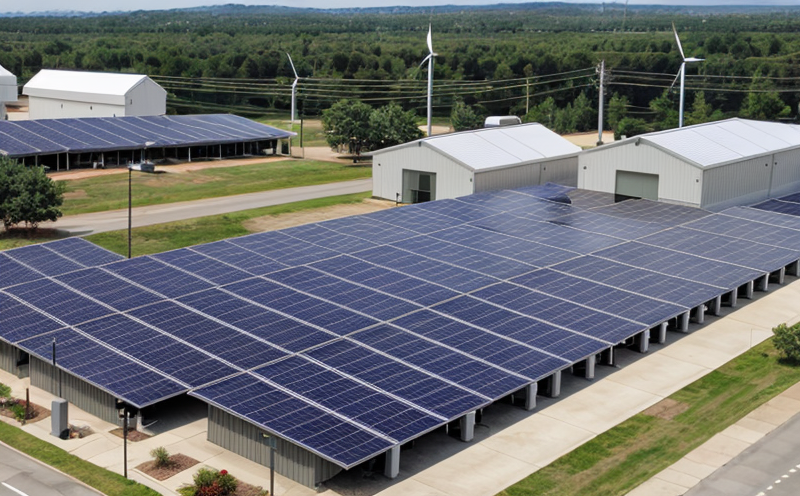ISO 15118 Vehicle-to-Grid Communication Testing in Distributed Systems
The ISO 15118 standard is a cornerstone of modern vehicle-to-grid (V2G) communication, enabling bidirectional power flow between electric vehicles (EVs) and the grid. In distributed systems, this standard ensures seamless integration of EVs into smart grids, enhancing efficiency and reliability. Distributed energy systems, such as microgrids, incorporate renewable resources like solar panels and wind turbines alongside battery storage to provide localized electricity generation and consumption.
Testing according to ISO 15118 is critical for ensuring that communication protocols between vehicles and the grid are robust and reliable. This testing involves simulating various scenarios to verify compliance with the standard, including power transfer capabilities, data exchange rates, and security measures. The goal is to ensure that all components of a distributed energy system can communicate effectively under real-world conditions.
The process begins with detailed planning and preparation. Specimen preparation includes setting up a controlled environment that mimics typical operational scenarios in microgrids. This setup allows for the accurate simulation of V2G interactions, enabling comprehensive testing of communication protocols. Instrumentation plays a vital role in monitoring these tests, providing real-time data on performance metrics such as latency, error rates, and security breaches.
Testing according to ISO 15118 involves multiple stages, each designed to evaluate specific aspects of V2G communication. Initial testing focuses on basic functionality, ensuring that all components can exchange essential information required for operation. Subsequent phases delve into more complex scenarios, such as handling large volumes of data or simulating emergency situations. Throughout these tests, rigorous adherence to international standards like ISO 15118 ensures consistency and accuracy.
One key aspect of this testing is the evaluation of security features. With increased reliance on V2G communication in distributed systems, ensuring secure data exchange is paramount. Tests are conducted to assess vulnerabilities and implement necessary safeguards against potential threats. This not only protects sensitive information but also enhances overall system resilience.
The results of ISO 15118 testing provide valuable insights into the performance and reliability of V2G communication within distributed systems. These findings inform continuous improvement efforts, allowing for the identification of areas needing enhancement or optimization. For instance, if certain protocols exhibit higher error rates under specific conditions, adjustments can be made to improve their robustness.
Another critical component of this testing is compliance verification. By adhering strictly to ISO 15118 standards, organizations ensure that their systems meet regulatory requirements and industry best practices. This compliance not only facilitates smoother integration into larger networks but also enhances trust among stakeholders. For quality managers and compliance officers, ensuring strict adherence to these standards is essential for maintaining high levels of operational integrity.
For R&D engineers, this testing offers a platform to innovate and refine technologies. By identifying gaps in current solutions, they can develop more efficient and reliable systems. This iterative process fosters advancements that ultimately benefit end-users by providing better service quality and cost savings. For procurement professionals, understanding these nuances helps in selecting suppliers who meet stringent technical specifications.
In conclusion, ISO 15118 vehicle-to-grid communication testing is crucial for the successful implementation of distributed energy systems. It ensures secure, reliable, and efficient interaction between vehicles and grids, supporting broader goals of sustainability and resilience.
Why It Matters
The importance of ISO 15118 vehicle-to-grid communication testing in distributed systems cannot be overstated. As renewable energy sources play an increasingly significant role in global energy mix, integrating electric vehicles into these systems becomes essential for optimizing resource utilization and enhancing sustainability.
- Enhanced Efficiency: By allowing bidirectional power flow between EVs and the grid, ISO 15118 facilitates efficient use of renewable resources. This integration can reduce peak load demands on traditional grids, thereby improving overall efficiency.
- Sustainability Goals: Meeting stringent environmental targets requires maximizing the benefits of both electric vehicles and renewable energy sources. ISO 15118 aligns with these goals by enabling better coordination between these components.
- Reliability: Reliable communication ensures that all parts of a distributed system function harmoniously, enhancing reliability and reducing potential failures.
In addition to the above benefits, ISO 15118 testing also promotes interoperability among different devices and platforms. This interoperability is crucial for fostering innovation and competition within the industry, ultimately leading to more advanced technologies and services.
Industry Applications
The applications of ISO 15118 vehicle-to-grid communication testing are broad and varied across different sectors, particularly in energy and renewable energy fields. This testing is crucial for ensuring that all components within a distributed system can communicate effectively under real-world conditions.
- Microgrids: In microgrid applications, ISO 15118 testing ensures that EVs are integrated seamlessly into localized power networks, enhancing both efficiency and resilience.
- Battery Storage Systems: By facilitating reliable communication between batteries and the grid, this testing supports more efficient use of stored energy.
- Solar Farms: In solar farm settings, ISO 15118 allows for better coordination between PV systems and storage solutions, optimizing energy output.
In each of these applications, rigorous testing according to ISO 15118 ensures that all components are compatible and operate efficiently within the broader distributed system. This compatibility is vital for achieving optimal performance and reliability.
Use Cases and Application Examples
- Smart Parking Lots: In smart parking lots, EVs can be charged while simultaneously providing power to nearby buildings through V2G communication. This setup not only reduces charging times but also contributes to grid stability.
- Demand Response Programs: ISO 15118 testing is essential for enabling effective demand response programs where EVs participate in shifting loads based on grid conditions, reducing peak demands and enhancing grid reliability.
- Residential Communities: In residential communities equipped with distributed energy systems, V2G communication allows for efficient management of home-based renewable resources, contributing to overall system stability.
These use cases illustrate the diverse ways in which ISO 15118 vehicle-to-grid communication testing enhances various applications within distributed systems. By ensuring reliable and secure communication, these tests pave the way for more sustainable and efficient energy management practices.





